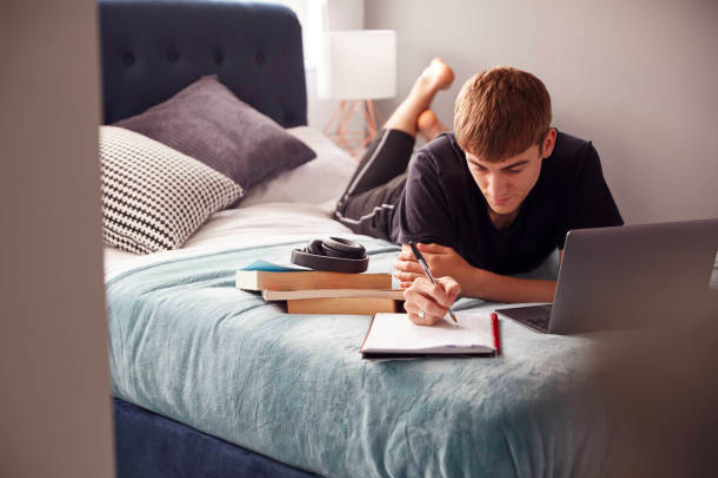Setting Up Your Workspace
Two students get home from school. The first immediately flops down on the living room couch, turns on Netflix, and watches a few shows. Eventually, she turns off the TV and reaches for her homework. As she works, she often stops to answer texts or scroll through TikTok. Her older brother comes in and turns on his own show. Two and a half hours after starting her homework, she finally finishes (having guessed on the last three math problems).
The second student, likewise, gets home from school. He takes a break, has a quick snack, and works out for a bit. Then, he goes to his room, turns on a desk lamp, and clears his desk. He gets his homework out, lists everything he has to do, and turns on some ambient music. Then, he gets to work. Just under an hour later, he finishes and has the rest of the evening to do whatever he wants.
The difference between these two students is not necessarily one of motivation or organization. Instead, their differences are in the time spent on homework and the quality of that work result from choices about environment.
Setting up a study space is one crucial skill for academic success. Students who effectively set up their environment not only do better in their homework, but they also develop important self-regulation skills that apply to other areas of life. Especially as they get ready for the independent work required in college, students need to know how to set aside time and space for studying.
A good study environment does two things: it removes distractions, and it makes the study process more efficient. You can help your child with both of these by following a few simple steps.
Get Rid of Distractions
Step 1: Study Alone
Especially in a home with other siblings, your child should make sure to complete their homework alone. If your child has to pause and restart their process every five minutes to talk to family members, the work will take them far longer. Of course, the exception to studying alone would be when study groups are created to review confusing class concepts or help quiz each other for an upcoming test.
Step 2: Clear off the workspace
Whether at kitchen table or their own desk, flat surfaces tend to accumulate a lot of junk. When your child starts working, encourage them to clear off anything that does not directly relate to their homework. This both puts them in an organized frame of mind and keeps them from getting distracted by random objects while they work.
Don’t do this
Do this
Step 3: Don’t watch anything (Netflix, TV, YouTube, etc.)
Too often, students try to make their homework less boring by simultaneously watching a show or video in the background. As we’ve outlined in our article on task management, multitasking doesn’t work. Instead, it increases the time spent on the work while decreasing its quality. Encourage your child to treat watching their show as a reward for finishing their homework rather than a simultaneous activity.
Also, if your child does homework on their computer, they might need help staying off YouTube while they work. Programs like Stayfocusd or Freedom block sites for predetermined amounts of time so that students can get work done.
Step 4: limit Noise
Your child should study in a quiet space, preferably their bedroom or a quieter corner of the house. In order to block out noise around the house, they can also listen to music, but it should be instrumental—lyrics can be just as distracting as conversations. Lots of students find classical music, lo-fi beats, or instrumental covers of pop songs great background noise for studying.
Make Studying Efficient
Step 1: Have enough space
While your child might enjoy the comfort of sprawling out across a couch or their bed, this prevents them from staying alert and organized. For any assignment that involves writing or typing, your child should study at a desk or a table, sitting upright, with space to set out several books (and a laptop if need be).
Don’t do this
Do this
Step 2: Collect the right materials
Your child should not have to interrupt their studying to riffle through their backpack, folders, or various corners of the house to get the right papers, textbooks, or writing utensils. Likewise, they shouldn’t have to spend a bunch of time scrolling through Google Classroom to find their assignments. Encourage your child to get their materials and assignments organized before they start studying, so that they can remain focused in one spot for the duration of their homework.
Step 3: Make sure the room is well-lit
Lighting impacts mood and alertness. Under bright lights, people stay awake and attentive, while dim lighting encourages people to relax and fall asleep. When your child does homework, a bright desk lamp over their workspace will keep them focused. Obviously, windows providing natural light are ideal!
Of course, the study space only makes up one part of making the homework process work well. For more information on getting work done well, check out our articles on effective learning strategies, motivation, task and energy management, and setting goals.




